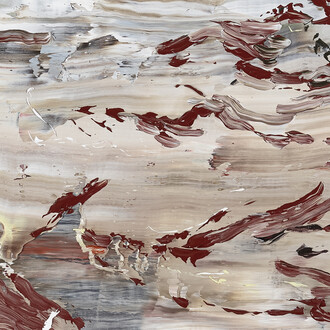Galleria Poggiali is delighted to announce the show Philippe Decrauzat: Teatro anatomico, the first show with the gallery by Philippe Decrauzat (Lausanne, 1974), which will open on Saturday 17 May 2025 at 6.00 pm. The show, curated by the art historian Matthieu Poirier, brings together a selection of about 25 works – some specially produced for the occasion – dating to various periods of the Swiss artist’s career and focused on exploration of the concept of ‘shaped canvas’.
The show will extend over both the premises of the gallery in Via della Scala and in the adjacent Via Benedetta, with the intention of offering an exhaustive articulation of the artist’s poetics through the broad scope of this project conceived specifically for the Florence venue.
Decrauzat has been invited to exhibit in the group show currently being hosted at the Fondation Carmignac in Porquerolles, running up to 2 November. His work is included in eminent public collections worldwide such as: Fondation Louis Vuitton (FLV), Paris, France; Kunsthaus Zürich, Zurich, Switzerland; Museo de Arte Contemporáneo de Buenos Aires (MACBA), Buenos Aires, Argentina; Museum of Modern Art (MoMA), New York City, NY, USA, Centre Pompidou, Brussels, Musée des beaux arts of Lausanne, and Musée des beaux arts of Rennes. Decrauzat is universally recognized as one of the outstanding global talents of the new generation of optical and kinetic art. In 2022 he was finalist in the prestigious Prix Marcel Duchamp. He has been invited to numerous public institutions, including MAMCO, Centre d’art contemporain in Geneva, creating environmental installations that combine sculpture, mural paintings and video projections, the MUDAM in Luxembourg, the Kunsthalle in Vienna, the Kunsthalle in Berne and the Musée National d’art Moderne – Centre Georges Pompidou in Paris.
The term ‘shaped canvas’ is used to describe canvases which depart from the traditional rectangular format of the painting to assume irregular or sculptural forms. For this particular Florentine show, these objects are conceived as spatial, perceptive, theatrical and metaphorical vehicles of human physiology rather than as post-concrete artistic creations connected with a formal rationale that appeared in the context of post-war abstract art.
All Decrauzat’s works consist of hand-painted canvases meticulously stretched on shaped wooden structures.
More specifically, on show in Florence are iconic works such as Delay inverted pentagon and Delay, Broadcasting delay magenta, both hexagonal in shape and dating to 2022, and Vertical wave red transmission from 2024, a species of undulating vertical banner, works that are central in the development of the poetics of the shaped form that made Decrauzat’s name. Alongside these works is the series Still double, also part of the same ‘shaped canvas’ cycle and produced especially for the show.
This is an approach that recalls the visual explorations of the Florentine Renaissance, a period in which the human body became the central subject of study and representation, not just in anatomical terms but also as a means of artistic and metaphysical enquiry. The display spaces of the Galleria Poggiali are transformed into a site of observation and revelation, a stage rather like that of an arena on which the pictorial body is laid bare. The wooden slats of the frames are conceived like bones that give the work its structural stability and define the skeletal system as a surrogate of the internal architecture of the body, tracing out a metaphorical parallel between the compositional support and the human skeleton.
Despite being abstract in nature, these works of art can be interpreted in a metaphorical sense in relation to our own bodies, acting as a reminder of how sight is inextricably bound up with the entirety of our physiological system.
Teatro anatomico invites observers to reflect on how these material elements – which are so often taken for granted as mere supports – can be transformed into expressive agents. It explores how the artist’s manipulation of form, surface, and structure creates a dialogue between our corporeal experience and the mechanical, sometimes banal, gesture of painting.
Finally, the show also probes the way in which the artist’s process is fuelled by the dynamic interaction between body, surface, and image, between the internal architecture of the work of art and the living, perceptive body that relates to it. The title of the show invites us to perform a species of visual dissection of the works so as to comprehend their form and function, and the theatrical implications of their optical effects in real time and space, making reference to actual anatomical studies.
(The show will be accompanied by a catalogue including an essay by the curator)












